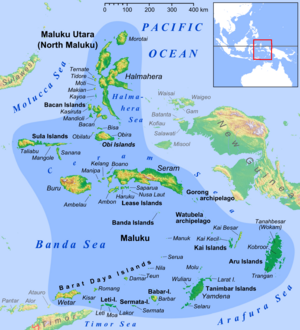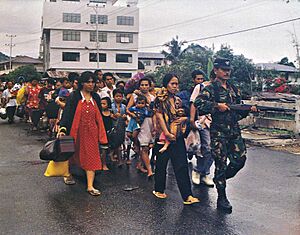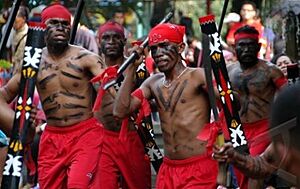Maluku (province) facts for kids
Quick facts for kids
Maluku
Moluccas
|
||
|---|---|---|
| Province of Maluku | ||
|
||
| Motto(s):
Siwalima (Ambonese)
Belong Together |
||

Location of Maluku in Indonesia
|
||
|
OpenStreetMap
|
||
| Capital and largest city |
Ambon | |
| Government | ||
| • Body | Maluku Provincial Government | |
| Area | ||
| • Total | 57,803.81 km2 (22,318.18 sq mi) | |
| Area rank | 15th in Indonesia | |
| Highest elevation
(Mount Binaiya)
|
3,027 m (9,931 ft) | |
| Population | ||
| • Total | 1,908,753 | |
| • Density | 33.021232/km2 (85.524597/sq mi) | |
| Demographics | ||
| • Ethnic groups | Significantly mixed ethnicity; Alfur, Ambonese, Chinese, Bugis, Butonese, Javanese, other Indonesians | |
| • Religion (2021) | Islam (52.85%) Christianity (46.3%) - Protestant (39.4%) - Catholic (6.9%) Hinduism (0.32%) Buddhism (0.02%) Folk religion (0.55%) |
|
| • Languages | Indonesian (official), Ambonese Malay (lingua franca), other languages | |
| Time zone | UTC+09 (Indonesia Eastern Time) | |
| ISO 3166 code | ID-MA | |
| HDI | ||
| HDI rank | 26th in Indonesia (2023) | |
| Website | malukuprov.go.id | |
Maluku is a province in Indonesia. It covers the central and southern parts of the Maluku Islands. The biggest city and capital of Maluku province is Ambon. It is located on the small Ambon Island.
Maluku shares borders with North Maluku, Southwest Papua, and West Papua to the north. To the west, it borders Central Sulawesi and Southeast Sulawesi. In the south, it is next to the Banda Sea, Australia, East Timor, and East Nusa Tenggara. To the east, it borders the Arafura Sea, Central Papua, and South Papua.
The land area of Maluku is about 57,800 square kilometers. In mid-2023, the total population was estimated to be around 1.9 million people. Maluku is located in Eastern Indonesia. The two main religions in Maluku are Islam (about 52.85% of the population) and Christianity (about 46.3%).
All the Maluku Islands were once part of one big province from 1950 until 1999. In 1999, the northern part of Maluku was separated. This new area became the province of North Maluku. The Seram Sea now divides the two provinces.
Contents
What's in a Name?
Historically, the name Maluku referred to four important kingdoms in North Maluku. These were Ternate, Tidore, Bacan, and Jailolo. They formed a group called Moloku Kie Raha, meaning "The Four Mountains of Maluku." This group likely started in the 14th century.
These four kingdoms grew and covered more areas. But the original term Maluku only meant the four main islands that produced cloves. These islands were Ternate, Tidore, Moti, and Makian. Bacan and Jailolo were also often included.
The exact meaning of the word Maluku is not fully clear. Some experts believe it comes from "Moloku Kie Raha." "Raha" means four, and "kie" means mountain. So, "Moloku Kie Raha" could mean "the confederation of four mountains." Another idea is that "Moloku" means "to grasp" or "to hold."
A Look Back in Time
Early Settlers and Spice Trade
The Maluku region was first settled by Melanesians over 40,000 years ago. These people are known as the Alifuru tribes. Later, people from Austronesia also moved to the islands.
In the early 14th century, the Majapahit Kingdom was powerful in Southeast Asia. Traders from Java controlled the spice trade in Maluku. Spices from Maluku became famous. Marco Polo even wrote about the clove trade during his visit to Sumatra.
European Arrivals and Control
The first Europeans to arrive in Maluku were the Portuguese in 1512. They landed in the Banda Islands and Penyu Islands. The Portuguese made friends with local leaders. They were allowed to build forts and gained control over the spice trade. They also started spreading Catholicism.
A famous missionary named Francis Xavier visited Ambon in 1546. He traveled to other islands to share the Christian faith.
However, the relationship between the Portuguese and the local Ternatean people became difficult. A war broke out in 1570. The Portuguese were forced to leave Ternate and moved to Tidore and Ambon.
The Dutch saw this as a chance to gain power. In 1605, the Dutch took over the Portuguese forts in Ambon and Tidore. They also destroyed a British fort. This gave the Dutch control over most of Maluku.
The Dutch became even stronger when the Dutch East India Company (VOC) was formed in 1602. The VOC controlled the clove trade in Maluku for almost 350 years. They fought against the Portuguese, Spanish, and British to keep this control. Many Moluccans suffered during this time.
During the Napoleonic Wars, British forces took over Maluku. But after a treaty in 1814, the British gave Maluku back to the Dutch in 1817.
The return of the Dutch led to strong resistance from the Moluccan people. On May 15, 1817, a leader named Thomas Matulessy, also known as Kapitan Pattimura, led an attack on Fort Duurstede on Saparua island. The Dutch leader and his family were killed. Pattimura was helped by other brave fighters like Philip Latumahina and Anthony Ribok.
News of Pattimura's victory inspired people across Maluku. Paulus Tiahahu and his daughter Martha Christina Tiahahu also fought the Dutch. However, the Dutch forces were too strong. On December 16, 1817, Pattimura and his friends were sentenced to death. Martha Christina Tiahahu died on a boat while being taken to Java.
Modern Times
During World War II, Japanese forces occupied Maluku in 1942. They attacked Ambon and faced resistance from local and Australian soldiers. After the battle, many Allied prisoners of war were killed in a sad event known as the Laha massacre.
Japan surrendered in 1945, and Indonesia declared its independence. Maluku became one of Indonesia's provinces. However, the Dutch tried to regain control. They stayed in Maluku until 1949.
In 1951, some Moluccans who did not trust the new Indonesian government declared an independent Republic of the South Moluccas (RMS). Many former Moluccan soldiers supported this. Indonesian forces invaded Maluku to stop the separatists. The RMS stronghold on Ambon was defeated in November 1950. Some fighting continued on Seram Island until 1962. Many Moluccan soldiers and their families later moved to the Netherlands.
In 1958, during a rebellion in North Sulawesi, the USA supported the rebels. Pilots from a CIA group flew planes and attacked targets on Ambon. One CIA pilot, Allen Pope, was shot down and captured. This showed the world the USA's involvement, and the support for the rebellion ended.
From 1999 to 2002, there was a period of fighting between different groups in Maluku. This conflict caused many houses to be destroyed. About 500,000 people had to leave their homes. Thousands of lives were lost. The fighting ended with the signing of the Malino II Accord in 2002.
Where is Maluku?
Maluku is mostly covered by sea. About 90% of its total area is sea, and only 10% is land. It has 559 islands. Some of the larger islands include Seram (18,625 km2), Buru (9,000 km2), Yamdena (5,085 km2), and Wetar (3,624 km2).
Maluku has a tropical monsoon climate. This means it has wet and dry seasons. The climate is greatly affected by the large amount of sea around the islands. The average temperature is around 26-27 degrees Celsius.
The land in Maluku varies a lot. Some areas are flat, especially near the coast. Other parts are hilly and mountainous. For example, Ambon has flat areas, but also bumpy, hilly, and mountainous parts. The highest mountain peak on Buru Island is Kapalamada, which is 2,736 meters above sea level.
Main Islands of Maluku

Here are some of the important islands in Maluku:
- Ambon Island
- Aru Islands (Kepulauan Aru)
- Banda Islands (Kepulauan Banda)
- Buru
- Kai Islands (Kepulauan Kai)
- Gorong archipelago (Pulau-pulau Gorong)
- Lease Islands (Kepulauan Lease) which include Saparua, Nusa Laut, and Haruku Islands
- Seram
- Southwestern Islands (Barat Daya Islands) including Wetar Island, Kisar Island, Romang Island, Damer Island, Leti Islands, Sermata Islands, and Babar Islands
- Tanimbar Islands (Kepulauan Tanimbar)
- Watubela archipelago (Kepulauan Watubela)
How Maluku is Governed
Maluku province is divided into nine regencies (kabupaten) and two cities (kota). These are like smaller administrative areas. The two cities are Ambon and Tual. Each regency and city has its own capital.
The province of Maluku is also an electoral district. It elects 4 members to the People's Representative Council.
People of Maluku
| Historical population | ||
|---|---|---|
| Year | Pop. | ±% |
| 1971 | 1,089,565 | — |
| 1980 | 1,411,006 | +29.5% |
| 1990 | 1,857,790 | +31.7% |
| 1995 | 2,086,516 | +12.3% |
| 2000 | 1,205,539 | −42.2% |
| 2010 | 1,533,506 | +27.2% |
| 2015 | 1,683,856 | +9.8% |
| 2020 | 1,848,923 | +9.8% |
| 2021 | 1,862,626 | +0.7% |
| 2022 | 1,881,727 | +1.0% |
| 2023 | 1,908,753 | +1.4% |
| Source: Badan Pusat Statistik 2023 and earlier. The sharp drop between 1995 and 2000 is due to the separation out in 1999 of the new province of North Maluku. | ||
Diverse Backgrounds
Over time, many people in Maluku have mixed with other ethnic groups. This includes Europeans (like Dutch, Portuguese, and Spanish) and Arabs. This mixing happened because foreign nations controlled the area for hundreds of years. This has made Maluku one of the most multiracial places in Indonesia.
Many Moluccans still have foreign last names. These come from countries like the Netherlands (e.g., Van Afflen, Gaspersz), Portugal (e.g., Da Costa, De Fretes), Spain (e.g., Oliviera, Diaz), and Arabic countries (e.g., Al-Kaff, Bachmid).
Today, Moluccan people live not only in Indonesia but also in other countries. Many moved to Europe in the 1950s, especially to the Netherlands. Others moved for better opportunities or married people from other nations. You can find Moluccan communities in the Netherlands, Suriname, and Australia. In Indonesia, Moluccans live in cities like Medan, Bandung, Greater Jakarta, and Makassar.
Languages Spoken
The languages in Maluku have been influenced by foreign languages. This is because explorers and colonizers from Spain, Portugal, Arabic countries, and the Netherlands visited and lived there.
The Ambonese language is the main language used for communication in Maluku. Most people in Maluku Province understand it. It is also understood by some people in other parts of Eastern Indonesia.
Indonesian is the official language of Indonesia. It is used in government offices, schools, and public places like airports.
Because Maluku has many islands spread far apart, there are many different languages spoken. Some common languages, besides Ambonese and Indonesian, include:
- Wemale language, spoken in parts of West Seram Regency.
- Alune language, used in three river areas in West Seram Regency.
- Nuaulu language, spoken by the Nuaulu tribe in southern Seram Island.
- Atiahu language, used by three ethnic groups in East Seram Regency.
- Seti language, spoken by the Seti people and used for trade in Eastern Seram.
- Tarangan language, spoken in the Aru Island region.
Beliefs and Religions
Religion in Maluku (2022) Islam (52.70%) Protestantism (39.58%) Roman Catholic (6.87%) Hinduism (0.37%) Buddhism (0.02%) Folk religion (0.46%)
Most people in Maluku follow either Islam (about 52.85%) or Christianity (about 46.3%). Christians are divided into Protestantism (39.39%) and Catholicism (6.87%). There are also people who follow folk religion, Hinduism, and Buddhism.
Islam was spread by local sultanates and Arab traders. Christianity was brought by missionaries from Portugal, Spain, and the Netherlands.
In 2013, there were many places of worship in Maluku:
- 2,345 churches
- 2,000 mosques
- 10 temples
- 5 Vihara
The Protestant Church of Maluku (Gereja Protestan Maluku or GPM) is the largest church organization in Maluku. It has churches in almost all Christian areas throughout Maluku.
Maluku's Economy
Maluku's economy has been improving over the years. One way to see this is by looking at its Gross Regional Domestic Product (GRDP), which has increased.
Because Maluku is mostly sea, its natural resources in fishing and marine life are very important. These are key businesses in Maluku. Other important areas include farming, forestry, trade, and tourism.
Currently, Maluku's economy relies heavily on agriculture, forestry, and fisheries. These areas make up about 25% of the total economy. Government services, defense, and social security also contribute a lot (around 21%). Other growing sectors include construction, transportation, and manufacturing.
In 2017, a Japanese oil company, Inpex Corporation, bought the Abadi Field. This is a large oil and natural gas field located near the Tanimbar Islands.
Culture and Traditions
Music of Maluku
Maluku has unique musical instruments. The most famous are the Tifa (a type of drum) and Totobuang. When played together, they form an ensemble called a Tifa totobuang. Each instrument has a different role, creating a special sound. The Tifa instruments are the most important. They include Tifa, Tifa Jekir, Tifa Dasar, Tifa Potong, Tifa Jekir Potong, and Tifa Bas. There's also a large Gong and Toto Buang, which are small gongs on a table. Another instrument is the Bia Skin (Shellfish), which is a wind instrument.
Maluku culture also uses stringed instruments like the Ukulele. This instrument is also found in Hawaiian culture. Maluku music often uses Hawaiian instruments in pop songs and traditional dances like Katreji.
Another musical style is Sawat, which mixes Maluku and Middle Eastern cultures. This blend happened centuries ago when Arab traders came to spread Islam. Sawat music uses instruments like Tambourines and Flutes, which are common in Arabian music.
Moluccan people are also known for their singing. Many famous Moluccan singers are well-known in Indonesia and the Netherlands. Some examples are Broery Pesulima, Daniel Sahuleka, Ruth Sahanaya, and Glen Fredly.
Traditional Dances
A famous dance from Maluku is the Cakalele. It shows the strength and bravery of the Moluccan people. Men usually perform this dance, holding a Parang (a type of sword) and a Salawaku (shield).
Another dance is Saureka-Reka, which uses sago palm fronds. Six women perform this dance, needing to be very precise and fast. The dance is accompanied by lively music.
The Katreji dance shows how young people interact. It is performed by pairs of men and women with energetic movements. This dance is similar to some European dances because it mixes European (Portuguese and Dutch) and Maluku cultures. The dance is accompanied by instruments like the violin, bamboo flute, ukulele, guitar, tifa, and bass guitar. Katreji is still performed today.
Another European-influenced dance is the Polonaise. Moluccans often perform it at weddings. People dance in pairs, forming a circle with simple movements that everyone can follow.
There is also the Crazy Bamboo Dance. This is a special, magical dance from Suli Village. The unique thing about this dance is that the dancers are pulled by bamboo that moves on its own. Anyone can join in this dance.
Places to Visit
Maluku has many beautiful places to visit. Some of the well-known tourist spots include:
- Manusela National Park
- Pasir Panjang Beach
- Natsepa Beach, Ambon
- City Gate, Ambon
Images for kids
See also
- Districts of Maluku
- List of islands of Indonesia
- List of Maluku governors
- List of rivers of Maluku (province)
- Baileo





